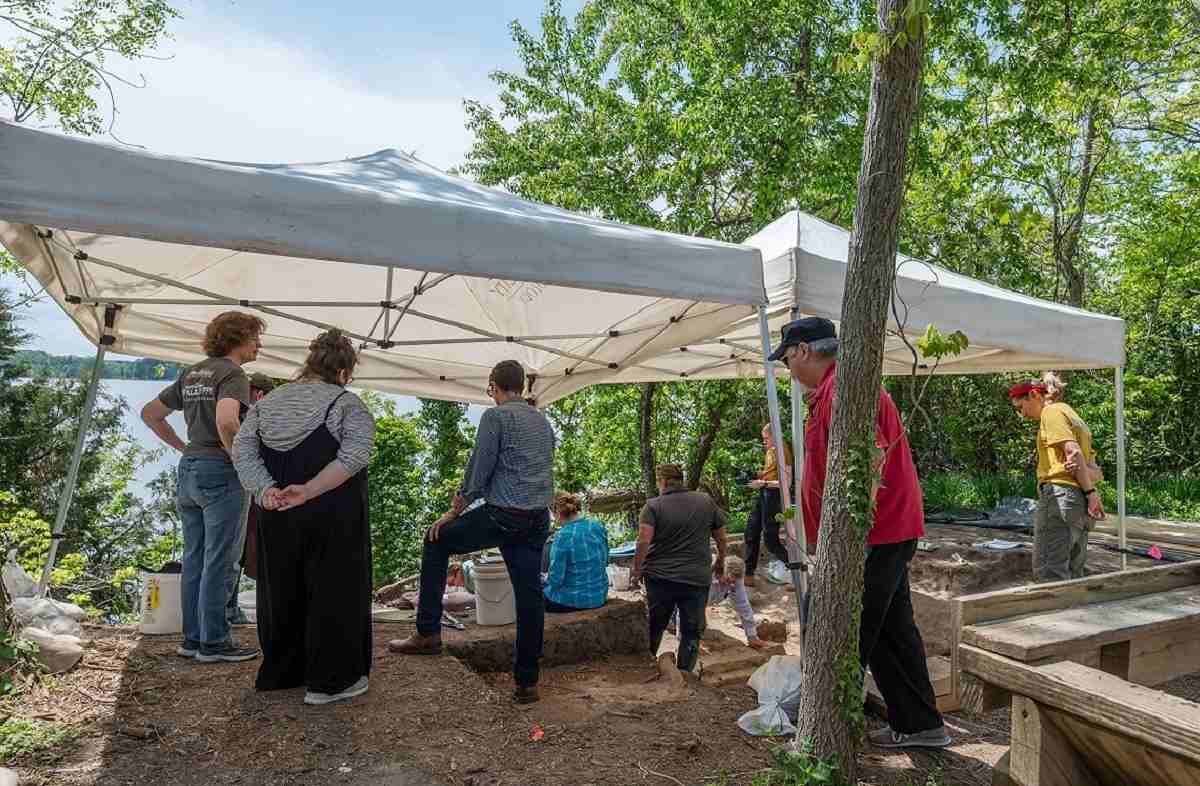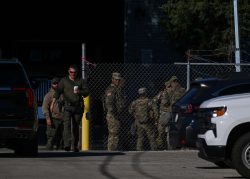
Members of the Historic St. Mary’s City, Md., department of research and collections and personnel from the Smithsonian Museum of Natural History excavate the remains of two enslaved people at a site in St. Mary’s City on April 27, 2023.
14:04 JST, June 18, 2023
He was buried beside the St. Mary’s River about 300 years ago, his hands folded over his stomach, his spine bearing the signs of the hard labor of the enslaved. A groove in one of his teeth where he clenched his pipe was still there.
She was buried on her side, as if sleeping, a few yards away. One of her teeth had been intentionally altered, most likely in Africa, experts said, before she was forced into enslavement in Maryland.
They were exhumed this spring to save them from the elements, and archaeologists have now declared that they are among the oldest African American burials ever found in the state.
“Together they represent two of the earliest . . . if not the earliest individuals of African descent ever studied in Maryland,” said Travis Parno, acting executive director of Historic St. Mary’s City, the organization that conducted the dig about 70 miles southeast of Washington.
The burials may have happened as early as the 1680s, he said in a recent telephone interview. “And at the latest, probably 1730s.”
The dig was conducted to save the remains, which had already been damaged by uprooted trees and erosion at the river, he said.
The woman’s burial was first identified in the 1970s. The man’s was identified in 1980. Both were left mostly in place because they weren’t then under threat, Parno said.
The project was undertaken with the support of the local African American community.
“If we didn’t disinter them,” much could have been lost, said Kelsey R.M. Bush, a member of the Chancellor’s Point Working Group, the community advisory team: “Not understanding the story . . . [not] understanding how hallowed the ground actually is.”
“Now we can put them at rest,” he said in a recent telephone interview. “And celebrate their spirit and perseverance and . . . that root from which we all came.”
Bush, who is also community affairs liaison at St. Mary’s College of Maryland, said too often the dark story of slavery has been ignored in the teaching of the country’s history.
“Growing up down here and visiting [historic sites] it was one of those things that you never envisioned yourself as being part of the picture,” said Bush.
“We need to tell truth,” he said. “We need to fund things like anthropology and archaeology. . . . Without them we don’t really understand ourselves.”
Bush said his family roots go back many generations in St. Mary’s, and his great-grandfather on his father’s side was born into slavery in Alabama.
“I wonder what my ancestors would think of me being employed here and getting paid to work here on land that they toiled on and spilled blood on,” he said. “This is a very special place for me in a different sort of way.”
The bones discovered along the river on land owned by the state of Maryland are now in the Historic St. Mary’s City laboratory.
The plan is to have them undergo examination at the Smithsonian Institution’s National Museum of Natural History, in Washington, and then be properly reburied. Those arrangements have not yet been made.
Douglas Owsley, the museum’s curator of biological anthropology, said the structure of the man’s face and skull, and the woman’s altered tooth, indicate that the two people were of African descent.
He said the alteration was in an upper front tooth and that other teeth, which are missing, were probably also modified.
Scholars have identified dental alteration as a cultural practice in Africa that shows up in some burials of the enslaved.
“I think this is a game-changing discovery for Historic St. Mary’s City [and] for Maryland,” Parno said. “These are two individuals who went unrecorded in the historical record” but who now add to the story of the period.
The first permanent White settlers came to what is now St. Mary’s City, in southern Maryland, in 1634. Enslaved Africans arrived soon after.
“From the early 1630s, we know there were enslaved people here,” Parno said. “Enslavement began from the outset” and spread dramatically over the next few decades.
The exhumation comes a few weeks after Parno’s team and anthropologists from the Smithsonian unearthed the remains of a teenage boy with a broken leg who is believed to be among Maryland’s first White colonists.
And in 2021, Historic St. Mary’s City announced that its experts had found the outlines of the long-lost fort that was erected by the first colonists. The two enslaved persons were buried about a mile and a half from that site.
“It speaks to the incredible archaeological legacy of St. Mary’s City,” Parno said in an email. “There is just so much history here and in addition to being Maryland stories, these are national stories . . . [and] key to that national narrative.”
The original 150 colonists, including many English Catholics fleeing Protestant persecution, arrived at St. Mary’s on two ships, the Ark and the Dove, in late March 1634.
The settlement, which was the colony’s first capital, was abandoned after the government moved to Annapolis in the 1690s.
But before the move, the Maryland legislature in 1664 enacted a comprehensive slavery code – the first in English-speaking North America, Parno said.
It decreed that “people of African descent are going to be enslaved for life, and their children for their lives as well,” he said.
Funeral rites “were one of the few [activities] enslaved Africans were allowed to conduct on their own, without any interference from the enslavers,” Henry M. Miller, Maryland heritage scholar with Historic St. Mary’s City, said in an email.
The exhumed man is thought to have been in his early 30s when he died, but he had the deteriorated spine of a man in his 50s, Parno said.
“That’s someone who did a lot of hard work in their life, a lot of backbreaking work,” he said.
The man also had a “pipe facet” in a tooth, a groove worn by a clay pipe he smoked – perhaps one of his few pleasures.
The man was buried with care, his hands folded, his body facing the water – “almost looking out at the mouth of the river,” Parno said, maybe “toward the avenue home.”
Bush, of the community group, said: “He’s facing down river towards Africa,” as if those who buried him were saying, “we’re sending you back.”
But several centuries later, the river had come too close and erosion had already carried away the man’s lower legs.
“This was a case of preservation,” Parno said. “We felt we had to do this project, and we only moved forward with it with the blessing of members of our community who said, ‘No, we need to save these burials.'”
The woman was buried on her side. She was 24 to 27 years old and had a modest build.
Decades before, a nearby tree had fallen, its roots knocking loose the modified tooth, which was recovered and saved.
The two people were probably of the same generation, or perhaps a generation apart, Parno said, both condemned to short, harsh lives in captivity.
It is possible that other burials may already have been lost to the river, and that others may be nearby, the experts said.
Either way, Bush said: “This could be a place that you could come and know that you could directly commune with individuals who we know were brought directly from the homeland to here, and were interred to return back to that same place.”
"News Services" POPULAR ARTICLE
-

American Playwright Jeremy O. Harris Arrested in Japan on Alleged Drug Smuggling
-

Japan’s Nikkei Stock Average as JGB Yields, Yen Rise on Rate-Hike Bets
-

Japan’s Nikkei Stock Average Licks Wounds after Selloff Sparked by BOJ Hike Bets (UPDATE 1)
-

Japan’s Nikkei Stock Average Buoyed by Stable Yen; SoftBank’s Slide Caps Gains (UPDATE 1)
-

Japanese Bond Yields Zoom, Stocks Slide as Rate Hike Looms
JN ACCESS RANKING
-

Tokyo Economic Security Forum to Hold Inaugural Meeting Amid Tense Global Environment
-

Keidanren Chairman Yoshinobu Tsutsui Visits Kashiwazaki-Kariwa Nuclear Power Plant; Inspects New Emergency Safety System
-

Imports of Rare Earths from China Facing Delays, May Be Caused by Deterioration of Japan-China Relations
-

University of Tokyo Professor Discusses Japanese Economic Security in Interview Ahead of Forum
-

Japan Pulls out of Vietnam Nuclear Project, Complicating Hanoi’s Power Plans
























